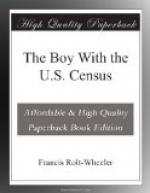“What is ze good of a question like zat?” she asked. “What does it matter if ze girls work all ze night to finish ze hat for ze gr-rand occasion, ze wedding, ze garden party? When zey work more, zey get more pay!”
“Of course,” said Hamilton diplomatically, “with such a number of society people as you deal with that must happen very often.”
It was a successful move. The Frenchwoman beamed on him.
“In ze season, yes, perhaps twenty or thirty evenings, but even zen ze girl go home by twelve o’clock.”
Hamilton smiled to himself as he did a little figuring and filled up the schedule to show the prevailing practice followed in the establishment during the year. He was a little dubious about asking the questions concerning the wages paid, but he found no trouble.
“In your kind of work,” he said, “I suppose the girls get good wages.”
“Ze very best,” the woman answered, and Hamilton found that this was true. Indeed, so anxious was she to impress on him how much better were the wages paid by her than those in other establishments that the boy secured a large amount of unexpected valuable information. But he came to a dead stop on the question of raw material used during the year. For the material used in wholesale work the figures were easily secured, but the retail trade was another matter. This the milliner really could not give, for, as she pointed out, most of the few especial customers she had, brought the materials to her to be made up, and she had no means of knowing what had been paid for them. Nor would she even try to make an estimate.
“But I must know,” said Hamilton, in despair. “See for yourself,—here it says that every factory must state the total cost of all material used during the year and the value of the products.”
“Factory!” the milliner jumped to her feet. “What you say—a factory! Zis establishment a factory! And me, one of ze designers of ze great Maison Chic in Paris! Zis is insult!”
For a moment Hamilton was amazed at the tempest he had so suddenly evoked; then he tried to pacify the woman.
“That’s just a general word,” he said, “and it is used for every place where things are made.”
“No, no, no,” she cried, “I know bezzer zan zat. A factory has chimney, high, high, and smoke, an’ nasty smells, an’ machines. I have seen zem!”
“That’s one kind of factory,” answered the boy, “but it is only one kind. But if you like we won’t use the word at all.”
This time, however, Hamilton’s persuasions were of no avail. The milliner had taken offense at the word “factory,” and not another word could the boy get out of her on any subject; the deadlock had become absolute when the door opened and the maid showed in a young girl, evidently a customer. The proprietress immediately greeted her in voluble French, recounting as nearly as Hamilton could judge from her gestures her sorrows and trials at the boy’s hands.




